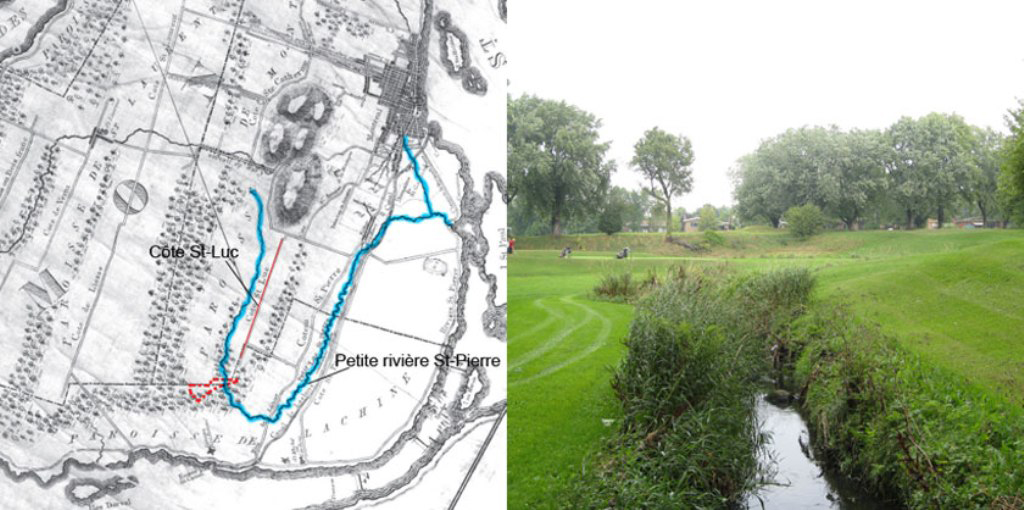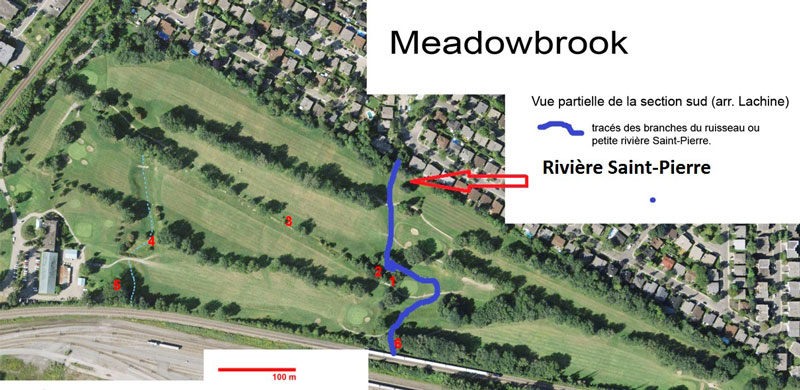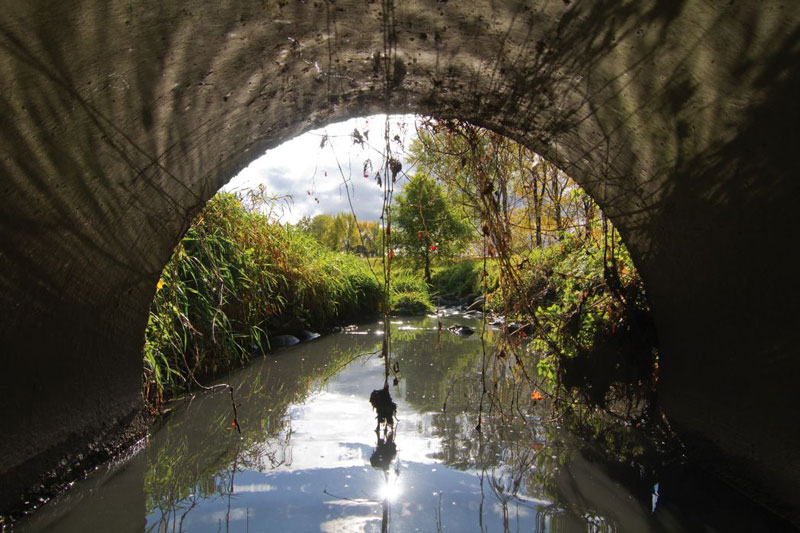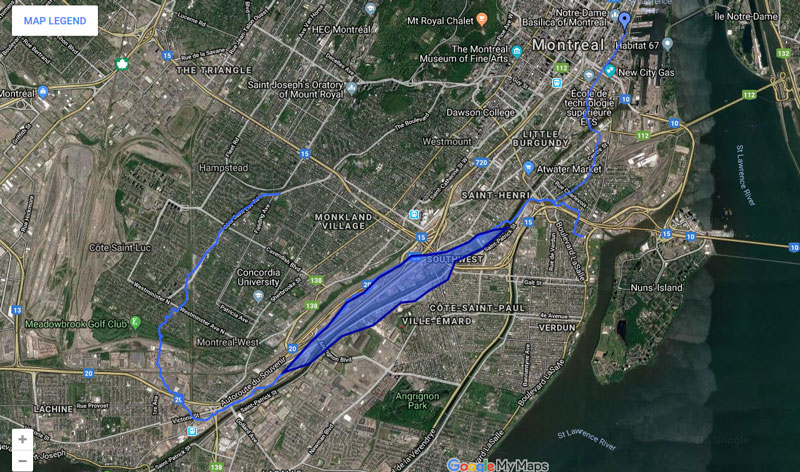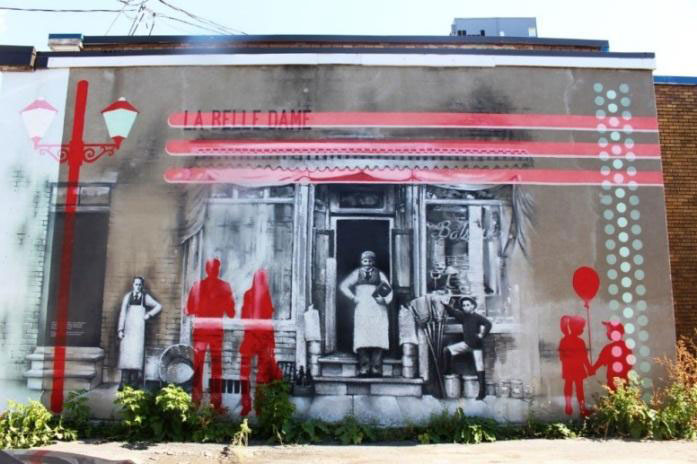The Epic Story of Noël LEGAULT (Le Goff) dit DESLAURIERS and his spouse Marie BESNARD dit LAJEUNESSE
Noël Legault (Le Goff) dit Deslauriers was born around 1673, the son of Roch Le Goff and Marie Galiou (Galion). We have not been able to locate Noël’s baptismal records but thanks to his marriage records, we know that he originated from the parish of Irvillac, in the diocese of Cornouailles. Noël was a native of the village of Kerinot, located approximately 25 km south of Brest, in the department of Finistère in Brittany. Several patrimonial remnants from Noël’s time remain today in the inclusive parish enclosure that is typical of Brittany. One can find the wall, the Saint-Pierre Church (1656), the original cemetery, the Calvary and the ossuary where Noël’s parents’ remains likely rest.
Noël probably arrived in Ville-Marie, today known as Old Montreal, around 1695. He was a soldier in the Compagnie Franche de la Marine (Company part of the French Royal Navy) under the command of François Le Verrier, Sire de Rousson. This hypothesis is most likely valid since he was still in the military at the time of his marriage and during the first years that followed. At that time, soldiers signed contracts of 3 to 6 years.
Noël et Marie’s Marriage
Noël married Marie Besnard dit Lajeunesse, François Gloria’s widow, on November 18, 1698 in the Saint-Nom-de-Marie Church, the first church in the Notre Dame parish. This church preceded the present basilica in Old Montreal. Marie, daughter of Mathurin Besnard dit Lajeunesse and Marguerite Viard, one of the King’s Daughters, was born in Chambly, Quebec on May 7, 1678. Marie was baptized in the Saint-Pierre de Saurel Church, today known as Sorel.
It seems that Noël did not know his exact date of birth because he declares himself to be between 24 and 25 on the day of his marriage. Marie also does not know her exact age as the mariage record has her age between 19 and 20. On the other hand, we know the exact date she was baptized because we now have in our possession the baptism records which confirm her date of birth as May 7, 1678. It does not appear that there were any objections to their union and the Sulpician superior and Grand Vicar, François Dollier de Casson, dispenses the couple from the publication of bans and the pastor of the Notre-Dame Parish, René-Charles de Breslay, blessed their union. On the previous day, that of November 17, the couple signed their marriage contract before notary Pierre Raimbault.
When Marie married Noël Legault, she was a widow and mother of two sons. Jean-Baptiste died as a child in 1697 and Pierre was born on February 13, 1698. She had married François Gloria on October 31, 1695 in the Saint-Nom-de-Marie Church. Two years later Marie and François settled on some land, on or close to the banks of the Saint Pierre River, in the area of Coteau de l’étang (pond) Saint Pierre, also known as Lac à la Loutre (nowadays it is a filled-up ditch). It extended at the base of the Saint Jacques cliff, from the Turcot interchange of today and stretching out westward. The Saint Pierre pond was fed on its west end by the Saint-Pierre River
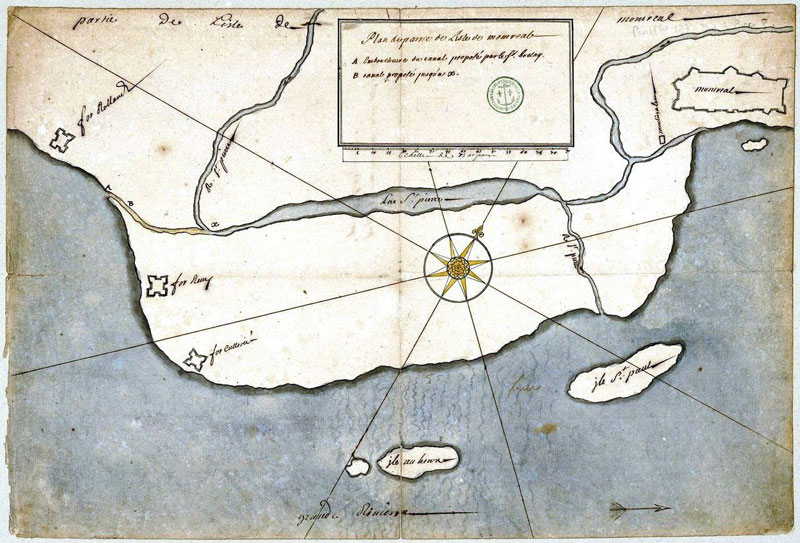
Source: Bibliothèque nationale de France, Maps and Plans Deparment GE SH 18 PF 127 DIV 8 P 2 D
Partial plan of the Montreal island.jpg
Creation: XVIIIth century date QS:P,+1750-00-00T00:00:00Z/7
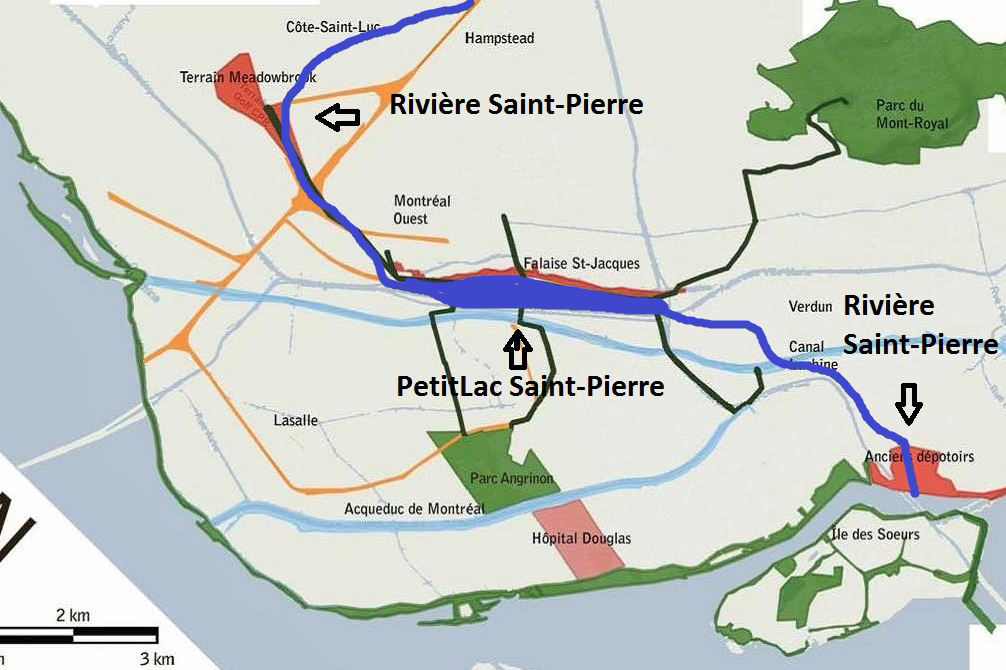
Nowadays, there is but a short 200-meter segment that does not have a canal system. This segment crosses the extreme east end of the Meadowbrook Golf Club, on the outskirts of the present limits of the Lachine and Montreal-West subdivisions. The land that belonged to Marie Besnard and her first husband, François Gloria is today part of the Meadowbrook Golf Club.
This same Saint-Pierre river also discharged at the east side of the pond into the Saint-Laurent River across from the Île des Sœurs, formerly known as Île Saint-Paul, near the aqueduct that runs from Montreal to Verdun. Under the French regime, a little canal was dug in response to the water needs of the population. This canal was called the Saint Pierre stream, or Little River. This stream was part of the pond and it ran into the Ville-Marie port. Nowadays, it flows up to the old port in Montreal, running underneath the museum in Pointe-à-Callières where it can still be seen.
In 1698, François Gloria was captured in a raid by the indigenous natives and disappeared, probably dying in captivity. According to a legal transaction notarized on April 24, 1699, Marie’s two brother-in-law, Jeans Cousineau and Mathurin Chartier become the legal guardians for Pierre, only a few months old at the time. Marie was also a minor.
Noël et Marie settle in Lachine
We can infer that Noël Legault dit Deslauriers knew François and Marie, as well as the area where they lived. Noël probably lived, or had lived there, since the naval soldiers were housed there and they served to protect the surroundings, lend a helping hand and working to alleviate the costs of the supply corps.
Placement on an actual map of the Saint-Pierre River and Lake in 1800. Google Maps 2009
It is on this land that touched the Saint-Pierre River and had belonged to the Gloria-Besnard couple that the newlyweds Marie and Noël settled. It is also in 1698 that Noël’s friend and fellow soldier, François Quéret dit Lavallée, obtained some land, as did numerous other soldiers. This land was on the limits of the Montreal subdivisions of Saint-Michel and Montreal-North, in the Grande Prairie area. He would then retrocede it to Noël in 1699 but the couple never occupied it. Nowadays, you would find it at the Grande-Prairies Boulevard on the northeastern side of the Île of Montreal.
Following the legal proceedings of the succession of François Gloria’s estate, Noël and Marie left their land in 1699. We don’t know where they might have lived from that time until they acquired some land in 1701. This land belonged to Pierre Sabourin’s and it was adjacent to the land on the slope of the Saint-Pierre River and it belonged to the heirs of the deceased François Gloria. Today it makes up part of the Meadowbrook Golf Club in Lachine. This acquisition was backed by an obligation to the Sire of Coüagne. In 1708, Noël and Marie found themselves obliged to give back the land due to outstanding debts owed to the Sire de Coüagne’s heirs. In the preceding year of 1707, always on the Coteau Saint-Pierre, Noël and Marie had purchased some land from Magdeleyne Michaud, the widow of Jacques Le Duc, and her new spouse, Geoffroy Lefèvre (Lefebvre). They also rented the adjacent land. In 1712, Noël sold the land to Jean Monet to repay the money still owed to the heirs of the Sire de Coüagne
In 1713, Noël decided to rent some land that included a stone house and other commodities from Sire François Lamoureux dit Saint-Germain and Marguerite Mesnard. The lease was for 7 years and the contract was renewed for 5 years at a time, ending in 1725. This land was located on the Côte Saint Paul on the other side of the river and St. Pierre Lake. Today it is known as Côte Saint-Paul and Lasalle, a bit to the east of the Mercier Bridge. Noël and Marie raised their family on this land.
In 1718, the Treaty of the Great Peace of Montreal was signed, and peaceful times made turning a profit on the land much easier. Noël and Marie acquired more land, more to the west, from Pierre Aymard and Marie Lalonde. It was near the hamlet of La Presentation, the origin of Dorval. This land was expanded at the back by a concession from the Sulpicians in 1723. Cut in two, this land was sold as a whole to their son Pierre-Noël in 1724. This land started at the Saint-Louis Lake to the west of the isle of Dorval in a northwest direction to the end of the runways of the Montreal airport.
In 1719, the Sulpicians granted some land located on the Côte Saint-Remy near the hamlet of La Presentation, today Montée Saint-Rémi in Dorval, to Noël and Marie. They would sell this to their son Jean-Baptiste in 1724. In March 1740, Noël, at the approximate age of 66, shared his assets with his sons. The youngest son, François-Marie, received the family farm and the animals, the buildings and equipment on condition that he lodged his parents and cared for them until the time of their death as was the custom at the time. A few months later he would retrocede the family farm, along with the conditions established previously, to his brother-in-law Ambroise Dubois dit Brisebois and his sister, Marie-Anne Legault.
Marie and Noël lived in La Présentation, now known as the city of Dorval, until the time of their deaths. Noël passed away in 1747 at the approximate age of 73 and Marie in 1760 at the age of 82.
Our first ancestors in Canada are buried in the crypt in the historic church in the Saint-Joachim parish in Pointe-Claire. They belonged to that parish until the time of their death as during this time, La Présentation had not yet been established as a parish.
Marie et Noël’s Descendants
Marie Besnard dit Lajeunesse ands Noël Legault dit Deslauriers had 14 children. From which child are you a descendant? You will find the answer in the archives of ADNLD Inc where you will find more than 69,429 entries along with photos, excerpts from registers, documents, books, etc.
To search with our name bank …
Commemorations
The Arboretum in the Parc de la Paix in Dorval is located in part on our ancestral land. In 2009, ADNLD Inc. planted a maple tree from Norway in memory of our ancestors Noël and Marie. In June 2018, a new commemorative plaque was offered to us by the commune of Irvillac, France and it was unveiled in the company of a delegation from Irvillac that would serve to reinforce the bonds that unite us.
The heritage buildings in Dorval, such as the Legault Manor and the Legault-Allard house, as well as the Avila-Legault Street among others, give evidence to the participation of their ancestors in the development of the city. We can still find several “Legault” enterprises on the streets that are still flourishing today. We cannot fail to mention that Dosithée Legault dit Deslauriers was mayor from 1897 to 1898.
Today in Pointe-Claire, we can still find the historic quarter in which is located the Noël Legault Community Centre. Everywhere on the west side of the Île of Montreal can be found several streets and heritage homes that bear the name Legault and Deslauriers, witnesses to the lineage of Marie and Noël.
You can also consult the newsletter Se Souvenir, Volume 15, Number 1 (March 2014) “Les Legault dans la toponymie des lieux” by Suzanne Hachez (m. 525) pages 12-17.
The Legault dit Deslauriers family also maintains a strong historic link with Lachine, Montreal, Quebec. In addition to having lived from 1698 to 1718, all of Noël and Marie’s sons were engaged for some time in the exploration of the West. They were men hired under contracts to row and portage huge commercial canoes and transport their merchandise that would leave Lachine. They would travel through dangerous and strong rapids to reach the Pays-d’en-Haut, or better known as the Great Lakes, to the mouth of the Missippi River, to the end of the Outaouais River and even the Red River in Winnipeg, Manitoba. They would return loaded with furs that would be transported to Europe.
Nowadays, in Lachine, on the exact spot where they would leave from and return from Pays-d’en-Haut, we have reconstructed the life and customs of the men known as the “engagés de l’Ouest”, or “the hired men of the West”. This can be seen at the Fur Trade of Lachine National Historic Site. One can also find a very large mural representing the storefront of the general store of Hormisdas Legault dit Deslauriers. This work can be found on the south side of Notre-Dame Street, between the 13th and 14th Avenues.
General storefront of Hormidas Legault dit Deslauriers around 1895.
Mural located at 1349 Notre-Dame Street realized in 2014 for the Maison des Jeunes l’Escalier of Lachine
City of Montréal – photo Natacha Gysin
References and collaboration:
- Association WAR HENTCHOU IRVILHAG: Gilbert, Crenn et Le Henaff, Patrick, (2017).
- Noël LE GOFF à Irvillac.Réflexions et hypothèses sur la vie de Noël LE GOFF à Irvillac
- Deslauriers, Jean, (2002). Noël dit Deslauriers l’ancêtre.
- Fournier, Marcel, (2005). Les bretons en Amérique française 1504-2004.
- Legault, Claude, (2001). Legault dit Deslauriers, Noël (Tomes 1 et 2); Un breton en Nouvelle-France.
- Legault, Conrad et al. (2005). Livre de Notre Ancêtre Noël Legault dit Deslauriers.
- Legault, Denise, (2001). Legault dit Deslauriers, Transcription d’actes notariés.
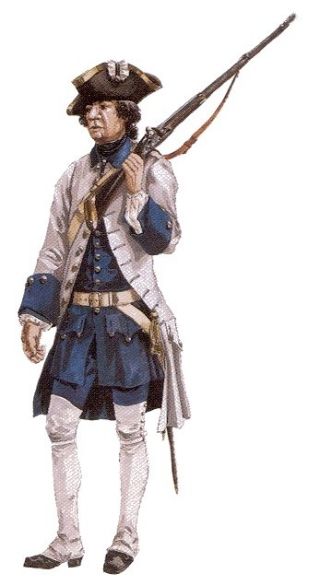
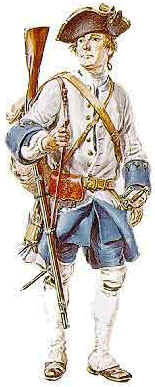
La compagnie Franche de la marine
The solders of the marine were gathered together in La Rochelle for their training, and they would leave from this port for New France. Their mission was to protect the local population and the colony’s forts, north of the Mississippi, the Great Lakes, from the Red River (Winnipeg, Manitoba), from the Outaouais river, along the St. Lawrence River up to the Richelieu and Hudson Rivers and Champlain Lake. They would always be under the threat of raids by the indigenous nations. The fear of attacks by these nations would last for nearly a century and finally came to an end with the signing of the Great Peace Treaty signed in Montreal on August 4, 1701. It would be signed by approximately 40 indigenous nations and more than 1300 emissaries that came from as far away as the Mississippi.
Patronym: Noël LEGAULT (Le Goff) dit DESLAURIERS
There are no Legault’s in Brittany, but we do meet several people with the name Le Goff which is the Gallicization throughout the centuries from the name Ar Goff in pure Breton. In Breton, two “F”’s at the end of a word, or a name, is not pronounced. They are as a matter of writing convention equivalent to a circumflex accent on the “o” that precedes the two “F”’s. Le Goff is therefore “Le Go” in Breton. Our ancestor was presumably pronouncing his name phonetically, “Le Go”. In his marriage records, his name Le Goff is phonetically written “Le Go”. On his marriage contract, his name has been changed to Legault by the notary Raimbault and that is where the North American name LEGAULT that we now use had its beginnings. He used the name Legault dit Deslauriers in full until the beginning of the XXth century. All the Legault’s of North America and numerous Deslauriers, as well as a few with the name Bastien and Godin, are descendants of Noël Legault dit Deslauriers and Marie Besnard dit Lajeunesse. We find a variety of spellings: Le go dit Deslauriers, le Gault, Deloriers dit Legault, Legau dit Deslauriers, Le Gaut, Legeau, Deslauriers.
The reason for the use of the name Deslauriers stems from the army because during this time, the soldiers were only known as by their French army names. His name Deslauriers most likely came from the bush characteristic of Finistère probably found around the ancestral home.
Notes
Since research in history and genealogy is an ongoing process, new documents and information may modify the information on hand. If you come across any such information, please don’t hesitate to share it with us.

